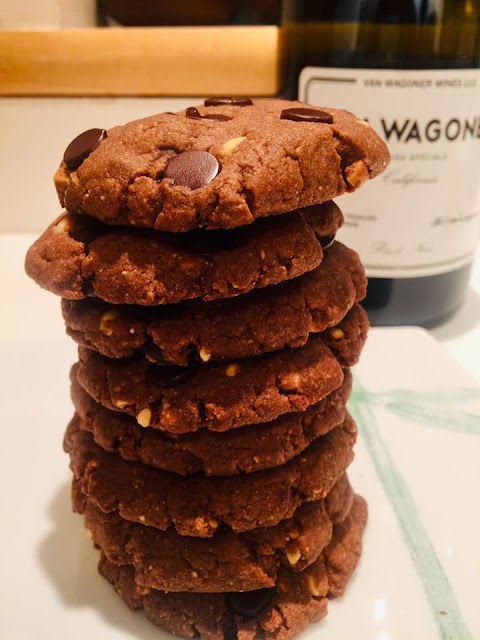Gratin is the culinary technique in which an ingredient is topped with a caramelized crust, often using breadcrumbs, grated cheese, egg or butter. The term may be applied to any dish made using this method. Gratin is usually prepared in a shallow oven-safe dish.
The etymology of gratin is from the French language words gratter, meaning "to scrape" or "to grate" (for example, "scrapings" of bread or cheese), and gratiné, from the transitive verb form of the word for crust or skin. The technique predates the current name which did not appear in English until 1846.
In addition to the well-known potato dishes such as gratin dauphinois, gratin may be applied to many other bases of meat, fish, vegetables, or pasta. Cauliflower, sweet potato, and shiitake mushrooms are excellent candidates for this treatment and also what I happened to have in ye olde cupboards. Whilst sweet potatoes are not strictly keto with the average sweet potato containing 37 grams of carbs (minus 5 grams of fiber), if you split this dish amongst two or more people, it's still a low-carb meal. I eschewed adding crumbs atop the casserole, but you can certainly add crumbled pork rinds or any low-carb cracker crumb topping for extra crunch - I opted for more cheese, instead. If you don't have a convection oven like I do, you may need to stick the gratin dish under the broiler for a minute to crisp the top properly to a golden brown.
This is a succulent and decadent casserole, do not let its gluten-free nature fool you. It beats Baked Mac and Cheese like a rented mule and is pure silk in mouthfeel because of the lack of flour in the cheese sauce. It reheats like a dream, too, not that there are ever any leftovers when el esposo is done cleaning up the kitchen;)
Keto Cauliflower-Shiitake Mushroom-Sweet Potato Gratin
Note: Instead of a traditional bechamel, I use sour cream and Boursin as thickening agent to help the cheese bind. Instead of blanching the cauliflower and sweet potato before immersing in the cheese sauce and baking, I saute the veggies with the aromatics and simmer them with the liquids —cooking it all in one pot before baking makes the gratin more nutritious and flavor-packed. Of course, it’s a rich sauce. Only use full fat dairy. You can play with different cheese combinations... Mascarpone, Gruyere, Comte, Fontina, Gorgonzola, Parmigiano-Reggiano etc etc in any combination would work great. The idea is to have a trifecta of yummy mix that includes a good melting cheese with a good creamy cheese with a strongly flavored cheese. This recipe will serve two as a main course, or 4-6 as a side dish.
Ingredients:
1 head of fresh cauliflower - washed, dried, and separated into florets
1 medium sweet potato - scrubbed, dried, and cut into coins that are 1/4” thick
1 small onion, sliced fine
2 garlic cloves, sliced fine
4 oz. shiitakes, de-stemmed & sliced
2 oz. pancetta (or thick cut bacon), diced thickly
1 small wheel of shallot-chive boursin (5 oz)
3 oz of gruyere, shaved with a plane (or coarsely grated)
2 TBSP sour cream
1 TBSP unsalted butter
2 TBSP extra virgin olive oil
1/4 cup of white wine
1/4 cup of stock (chicken or vegetable)
1/4 cup half and half (or cream)
freshly milled black pepper (to taste)
truffle oil (to taste)
1 sprig of thyme (leaves only, finely minced)
tsp of Dijon mustard (optional)
1 - 8 x 8 gratin dish
Instructions:
Preheat your oven (with the convection fan if you have one***) to 375 degrees
Heat a dutch oven over medium heat, add olive oil and butter, when hot but not smoking, add onions, saute until translucent (about 3 minutes), then add pancetta, saute with onions until fat begins to render, then add cauliflower florets, stirring well, adding more olive oil if pan seems dry, then add shiitakes, sweet potato coins and sliced garlic, incorporating well with the rest.
I sauté the veggies in olive oil and butter with pancetta, onion, garlic and shiitakes until both vegetables lose their raw look, absorb flavor, and take on a little golden color - then I deglaze the pan with a little white wine, add a few generous splashes of stock and half and half, lower the heat to a bare simmer and cover the pot tightly with a well-fitted lid for 15 minutes or so until the veggies have absorbed most of the liquid.
Then I add the sour cream and boursin mixing well, season it with freshly milled black pepper, and chopped scallions, dijon, and thyme, pour it all into a small (8x8) gratin dish, top it with a layer of freshly grated gruyere, mix the grated cheese in, finish it with another layer of freshly grated gruyere, drizzle some truffle oil on top and pop it into a preheated 350 F degree convection oven for 30 minutes, until the top is golden and the casserole is bubbling.
***If you don’t have a convection oven, you may need to place the dish under the broiler for a minute, to get a golden crust. Buen provecho.































